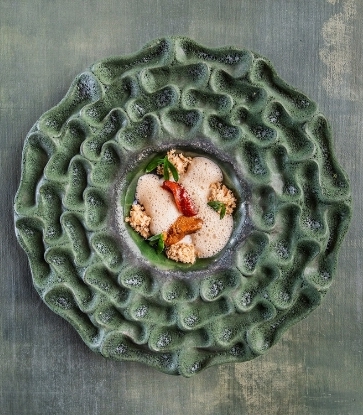This unusual stuffed pepper becomes a beloved special on menus across Mexico around the September Independence Day holiday. Chef Gerardo Vázquez Lugo of Mexico City’s Nicos discusses how the dish found its way to the center of Mexican culinary history.
To the casual diner, the only thing that may seem Mexican about the chile en nogada, a dizzying dozen-ingredient stuffed pepper that’s Mexico’s most patriotic dish, is its coloring: the same vibrant red, white, and green of the country’s triple bar flag.
The pomegranate seeds that are flecked on top are not native to Mexico and appear in few other recipes. The creamy walnut sauce poured over it is similarly single use.
But to Chef Gerardo Vázquez Lugo of Nicos, which makes the most sought-after serving of the entree in Mexico City, the chile en nogado “is a dish that screams Mexican identity.”
The poblano pepper that’s sliced open and filled is like any chili, “an ingredient at the center of our identity,” he says. “And the picadillo,” the minced meat mélange spooned inside, “is very complex and baroque, like us Mexicans.”

Like the pumpkin spice-ification of U.S. coffees in the fall, the chile en nogado emerges each August and September as a featured special in central Mexico at restaurants of all stripes.
No place in the capital is more synonymous with the dish than Nicos, a longtime homestyle establishment in the north of the city: Last year the restaurant sold more than 7,000 of the stuffed peppers over the short season.
The dish, served warm or room temperature, is a celebratory order, often enjoyed with family and friends around Mexico’s September 16 Independence Day holiday.

Legend has long tied the dish’s creation to the 1821 toppling of Spanish colonial rule in Mexico. In one version of its origins, Augustinian nuns prepared the dish at a feast honoring Agustín de Iturbide, the first emperor of Mexico, who led the victorious Army of the Three Guarantees.
Another, more romantic retelling, says it was the high society sweethearts of soldiers returning from the war who invented the recipe, with ingredients picked to match the colors of the winning army’s banner.
In fact, food researchers have uncovered recipes for the dish that predate the insurgency, revealing a dish more reflective of its extraordinary birthplace and a late-summer harvest than of intrinsic nation-building character.
“The legends are precious. But what’s really important to me is where the recipe actually comes from, which is the countryside of (the state of) Puebla,” Vázquez Lugo says.
“It’s not just any kind of ingredient that can adapt to this region, the slopes of the Popocatépetl volcano. The fruits grown there are more sweet, less juicy, and hard, so you can make a picadillo that won’t fall apart and become a puree,” he continues.

For his picadillo filling, Vázquez Lugo adds sauteed apples, peaches, and pears, to a mixture of beef, pork, almonds, and pinenuts that’s lightly sweetened with xoconostle, a mild cactus fruit, as well as raisins and sugar.
The green poblano pepper is charred on an open flame to impart smokiness and then scrubbed of its burn marks.
The recipe for the thick, airy sauce that blankets the dish is ancient and simple, to not step on the flavor of its star ingredient. Lugo uses fresh walnuts, which have a cool, fleshy texture, blended with goat cheese, milk, and sugar.
“You have to keep in mind that the protagonist of the dish is the nut. You have to give all the importance to the nut,” says María Elena Lugo Zermeño, Vázquez Lugo’s mother, who has been designing Nicos menu since she took over the restaurant more than 65 years ago.
“My mom is a purist. She wants everything to taste like what it is,” Vázquez Lugo says.
Since its earliest days as a humble neighborhood hangout, Nicos has served classic Mexican favorites, with recipes coming from Lugo Zermeño’s family. “I started with the recipes that were given to me by my mother, my grandmother, my aunt, my sister, my neighbor, recipes from the market,” she says.
The first recipe for chiles en nogada came from friends of Lugo Zermeño from Puebla and was introduced in the restaurant in one of its quietest periods. Set in an industrial zone surrounded by factories, the restaurant always emptied out in late summer when the workers went on vacation. That afforded the kitchen an opportunity to experiment with the complex and laborious dish, Gerardo says.
“As people began to try it, they liked our version, which is very traditional and purist, but with fully realized flavors and textures. It’s become a favorite of Mexico City through word of mouth, and every year the expectation and name grow and grow and grow,” Vázquez Lugo says.
Hero image: Viktor Martinez / Nicos





















